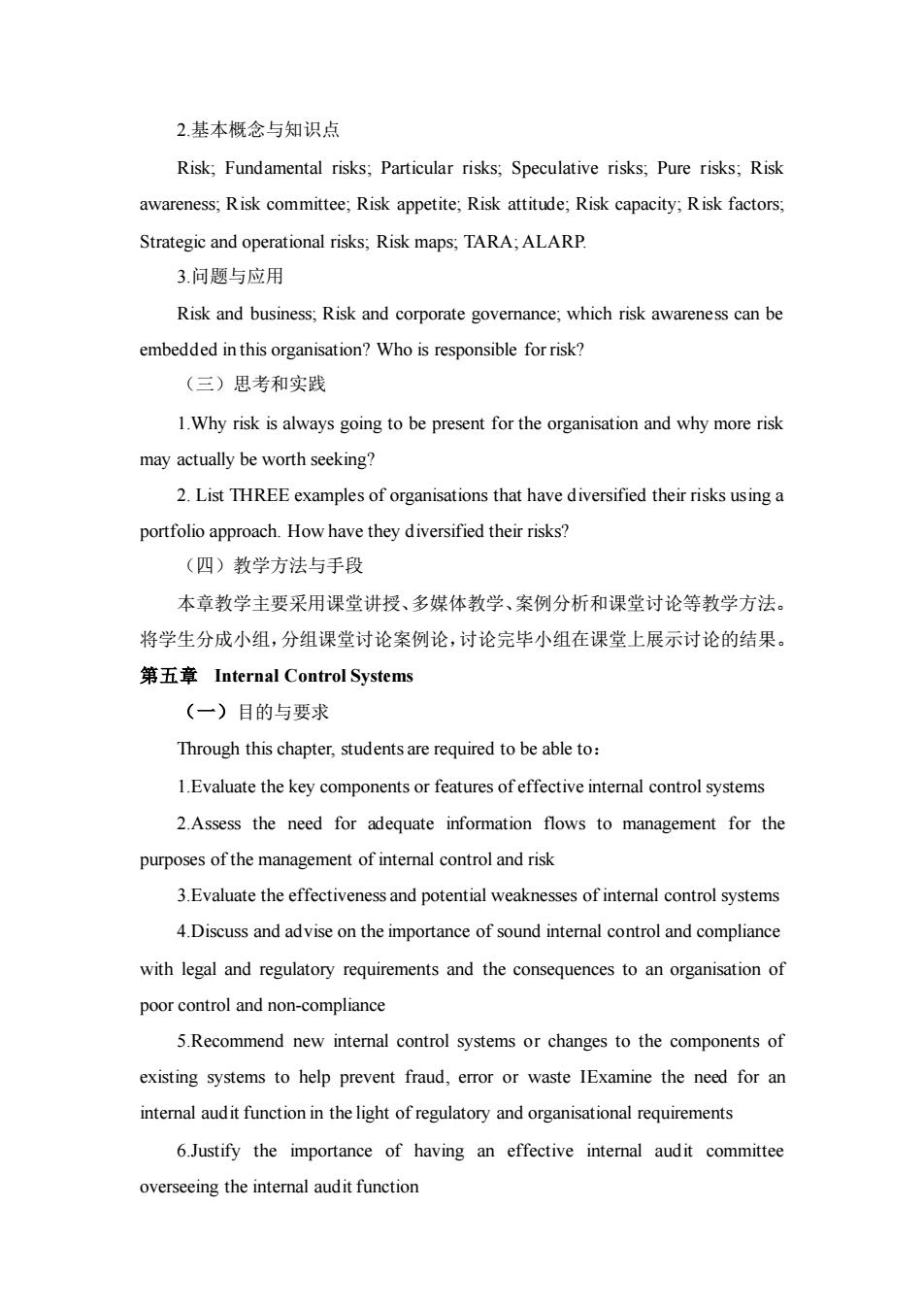正在加载图片...

2.基本概念与知识点 Risk;Fundamental risks;Particular risks;Speculative risks;Pure risks;Risk awareness,Risk committee;Risk appetite,Risk attitude;Risk capacity;Risk factors. Strategic and operational risks;Risk maps;TARA:ALARP 3.问题与应用 Risk and business.Risk and corporate governance:which risk awareness can be embedded in this organisation?Who is responsible for risk? (三)思考和实践 1.Why risk is always going to be present for the organisation and why more risk may actually be worth seeking? 2.List THREE examples of organisations that have diversified their risks using a portfolio approach.How have they diversified their risks? (四)教学方法与手段 本章教学主要采用课堂讲授、多媒体教学、案例分析和课堂讨论等教学方法。 将学生分成小组,分组课堂讨论案例论,讨论完毕小组在课堂上展示讨论的结果 第五章Internal Control Systems (一)目的与要求 Through this chapter,students are required to be able to: 1.Evaluate the key components or features of effective internal control systems 2.Assess the need for adequate information flows to management for the purposes of the management of intemal control and risk 3.Evaluate the effectiveness and potential weaknesses of interal control systems 4.Discuss and advise on the importance of sound intemal control and compliance with legal and regulatory requirements and the consequences to an organisation of poor control and non-compliance 5.Recommend new internal control systems or changes to the components of existing systems to help prevent fraud,error or waste IExamine the need for an interal audit function in the light of regulatory and organisational requirements 6.Justify the importance of having an effective internal audit committee overseeing the internal audit function 2.基本概念与知识点 Risk; Fundamental risks; Particular risks; Speculative risks; Pure risks; Risk awareness; Risk committee; Risk appetite; Risk attitude; Risk capacity; Risk factors; Strategic and operational risks; Risk maps; TARA; ALARP. 3.问题与应用 Risk and business; Risk and corporate governance; which risk awareness can be embedded in this organisation? Who is responsible for risk? (三)思考和实践 1.Why risk is always going to be present for the organisation and why more risk may actually be worth seeking? 2. List THREE examples of organisations that have diversified their risks using a portfolio approach. How have they diversified their risks? (四)教学方法与手段 本章教学主要采用课堂讲授、多媒体教学、案例分析和课堂讨论等教学方法。 将学生分成小组,分组课堂讨论案例论,讨论完毕小组在课堂上展示讨论的结果。 第五章 Internal Control Systems (一)目的与要求 Through this chapter, students are required to be able to: 1.Evaluate the key components or features of effective internal control systems 2.Assess the need for adequate information flows to management for the purposes of the management of internal control and risk 3.Evaluate the effectiveness and potential weaknesses of internal control systems 4.Discuss and advise on the importance of sound internal control and compliance with legal and regulatory requirements and the consequences to an organisation of poor control and non-compliance 5.Recommend new internal control systems or changes to the components of existing systems to help prevent fraud, error or waste IExamine the need for an internal audit function in the light of regulatory and organisational requirements 6.Justify the importance of having an effective internal audit committee overseeing the internal audit function